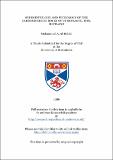Files in this item
Sedimentology and petrology of the carboniferous rocks of St Monance, Fife, Scotland
Item metadata
| dc.contributor.advisor | Walton, E. K. (Ewart Kendall) | |
| dc.contributor.author | Al-Rubaii, Mohammed A. | |
| dc.coverage.spatial | 358 p. | en_US |
| dc.date.accessioned | 2018-07-17T10:35:43Z | |
| dc.date.available | 2018-07-17T10:35:43Z | |
| dc.date.issued | 1986-07 | |
| dc.identifier.uri | https://hdl.handle.net/10023/15469 | |
| dc.description.abstract | 1. The rooks of the study area belong to the upper part of the Carboniferous Sandstone Series, and the Lower Limestone Group of the St Monance syncline. The succession consists of alternating limestones, shales, siltstones, and sandstones with occasional coals. Six sedimentary cycles were examined, and the boundaries to cycles were taken at those points where a carbonate lithology occurs. 2 Sedimentary structures include rib-and-furrow structures, large-scale, mainly through cross-lamination, hummocky cross-stratification, and deformation structures including pseudonodules. Lenticular, wavy and flaser bedding are common. The main palaeocurrent directions are towards the south-west. 3 Sediment distribution, structures, and grain size studies lead to the depositional model of deltaic sediments prograding from NE to SW. 4 Petrological studies by optical microscope, SEM, and X-ray diffraction have been carried out especially on the sandstones. The rocks classify as orthoquartzites. The provenance suggested is principally one of low-grade metamorphic rocks. 5 Studies of diagenesis show cements of carbonates, quartz and Iron-oxides. Authigenic clay minerals are mainly kaolinite with smaller amounts of illlte, chlorite and smectite. 6 The amount of original pore space has been reduced by precipitation of cement and clays. Before the reduction the porosity value may have reached 40%. Two methods were used to get the actual amount of porosity, core sample and thin-section, and they gave values of 30-60% and 25% respectively. The sandstones are mostly permeable, and the pore types associated are intergranular, either formed through dissolution of carbonate cement or other unstable materials. If there has been little or no dissolution, and/or if a high amount of clay is present, microporosity is developed and thirteen types have been recognized. Microporosity may reach up to 89/t of the total porosity as determined by mercury Injection. | en_US |
| dc.language.iso | en | en_US |
| dc.publisher | University of St Andrews | |
| dc.subject.lcc | QE471.2A6R9 | |
| dc.subject.lcsh | Petrology | |
| dc.subject.lcsh | Sandstone | |
| dc.title | Sedimentology and petrology of the carboniferous rocks of St Monance, Fife, Scotland | en_US |
| dc.type | Thesis | en_US |
| dc.type.qualificationlevel | Doctoral | en_US |
| dc.type.qualificationname | PhD Doctor of Philosophy | en_US |
| dc.publisher.institution | The University of St Andrews | en_US |
This item appears in the following Collection(s)
Items in the St Andrews Research Repository are protected by copyright, with all rights reserved, unless otherwise indicated.

